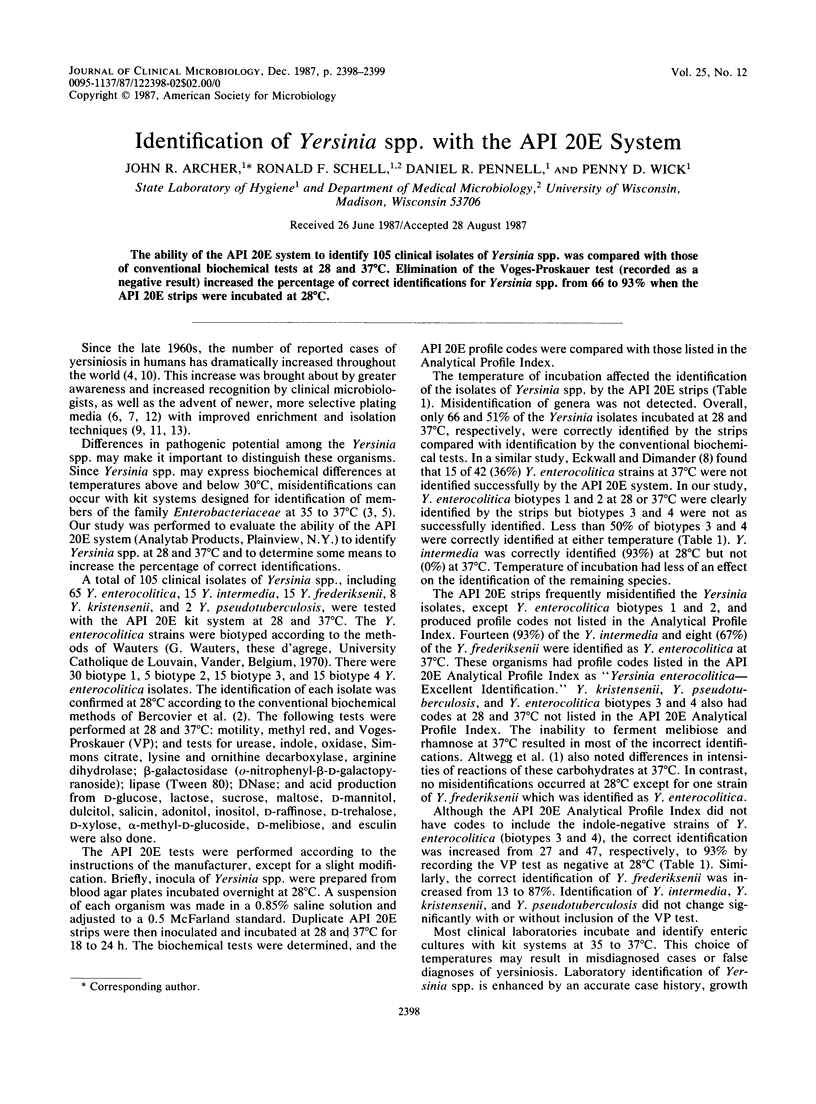Abstract
The ability of the API 20E system to identify 105 clinical isolates of Yersinia spp. was compared with those of conventional biochemical tests at 28 and 37 degrees C. Elimination of the Voges-Proskauer test (recorded as a negative result) increased the percentage of correct identifications for Yersinia spp. from 66 to 93% when the API 20E strips were incubated at 28 degrees C.
Full text
PDF

Selected References
These references are in PubMed. This may not be the complete list of references from this article.
- Altwegg M., Altorfer R., Schär G. Isolation and identification of Yersinia enterocolitica requires incubation temperatures below 37 degrees C. Eur J Clin Microbiol. 1983 Apr;2(2):152–153. doi: 10.1007/BF02001583. [DOI] [PubMed] [Google Scholar]
- Bottone E. J. Yersinia enterocolitica: a panoramic view of a charismatic microorganism. CRC Crit Rev Microbiol. 1977;5(2):211–241. doi: 10.3109/10408417709102312. [DOI] [PubMed] [Google Scholar]
- Dudley M. V., Shotts E. B., Jr Medium for isolation of Yersinia enterocolitica. J Clin Microbiol. 1979 Aug;10(2):180–183. doi: 10.1128/jcm.10.2.180-183.1979. [DOI] [PMC free article] [PubMed] [Google Scholar]
- Ekwall E., Dimander M. Comparison of micro-ID with API 20E for identification of Salmonella, Shigella and Yersinia species. Eur J Clin Microbiol. 1982 Jun;1(3):134–137. doi: 10.1007/BF02019612. [DOI] [PubMed] [Google Scholar]
- Greenwood J. R., Flanigan S. M., Pickett M. J., Martin W. J. Clinical isolation of Yersinia enterocolitica: cold temperature enrichment. J Clin Microbiol. 1975 Dec;2(6):559–560. doi: 10.1128/jcm.2.6.559-560.1975. [DOI] [PMC free article] [PubMed] [Google Scholar]
- Meadows C. A., Snudden B. H. Prevalence of Yersinia enterocolitica in waters of the lower Chippewa River Basin, Wisconsin. Appl Environ Microbiol. 1982 Apr;43(4):953–954. doi: 10.1128/aem.43.4.953-954.1982. [DOI] [PMC free article] [PubMed] [Google Scholar]
- Pai C. H., Sorger S., Lafleur L., Lackman L., Marks M. I. Efficacy of cold enrichment techniques for recovery of Yersinia enterocolitica from human stools. J Clin Microbiol. 1979 Jun;9(6):712–715. doi: 10.1128/jcm.9.6.712-715.1979. [DOI] [PMC free article] [PubMed] [Google Scholar]
- Schiemann D. A. Synthesis of a selective agar medium for Yersinia enterocolitica. Can J Microbiol. 1979 Nov;25(11):1298–1304. doi: 10.1139/m79-205. [DOI] [PubMed] [Google Scholar]
- Weissfeld A. S., Sonnenwirth A. C. Yersinia enterocolitica in adults with gastrointestinal disturbances: need for cold enrichment. J Clin Microbiol. 1980 Feb;11(2):196–197. doi: 10.1128/jcm.11.2.196-197.1980. [DOI] [PMC free article] [PubMed] [Google Scholar]


